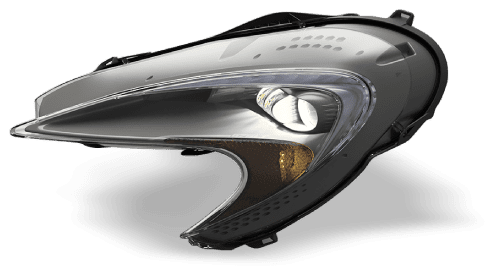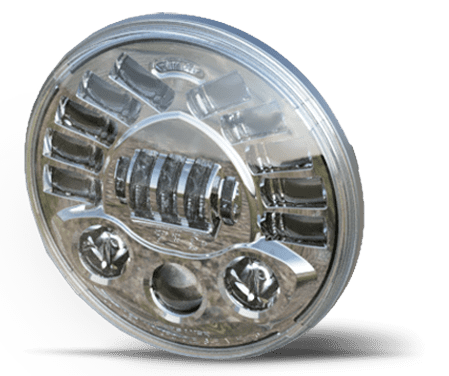
Comparing Projector vs. Reflector LED Headlights

When upgrading your vehicle’s lighting, the choice between projector and reflector LED headlights is a critical decision. Each technology offers distinct advantages, and understanding their differences is the key to selecting the right system for your needs.
The right headlights do more than just illuminate the road; they enhance visibility, improve safety, and define your vehicle’s appearance. Let’s compare projector vs. reflector LED headlights so you can find the perfect match for your vehicle.
Projector Headlights: What To Know
Projector headlights use an advanced optical system to control the light beam. The system directs the LED light source through a lens inside the assembly; the lens is like a magnifying glass. This setup goes with a cutoff shield, a small metal plate that creates a distinct, sharp upper edge for the low-beam pattern.
Providing Top-Tier Precision
The primary function of this design is precision. The lens focuses the light into a concentrated, powerful beam, while the cutoff shield prevents light from scattering upwards and glaring into the eyes of oncoming drivers. This design results in a controlled, well-defined light pattern that illuminates the road exactly where needed.
Some modern vehicles, particularly those in premium segments, come factory-equipped with projector headlights due to their superior performance and stunning, modern aesthetic.
Reflector Headlights: What To Know
Reflector headlights, the more traditional of the two designs, use a simpler and more established technology. The system consists of a bowl-shaped housing lined with a chrome-finished, reflective surface.
The LED bulb is the focal point of this bowl. When the LED is illuminated, the light radiates outward and bounces off the carefully angled surfaces of the reflector. These multiple reflections gather and direct the light forward, creating a wide, dispersed beam.
Unlike projector headlights, traditional reflector systems lack a sharp cutoff line, which can result in more peripheral light and potential glare. However, modern reflector designs for LEDs have improved, using complex, multifaceted surfaces to better control the beam pattern and reduce stray light.

Key Design and Functional Differences
The fundamental difference between projector and reflector headlights boils down to how they manage and direct light. Projector headlights use a lens and cutoff shield to produce a focused, sharp, and precisely controlled beam. This is an active method of light management. Reflector headlights use a reflective bowl to gather and cast light forward, resulting in a broader, more scattered pattern. This is a passive method of light management.
The cutoff shield in projector systems is a major distinction. It creates the flat-topped beam pattern characteristic of these headlights so light gets concentrated on the road and not in the eyes of other drivers. Reflector headlights typically have a less defined top edge to their beam, though advanced engineering has improved their focus over the years.
Performance and Light Output Comparison
Performance is where the differences between these two technologies become most apparent.
Defining the Beam Pattern
Projector headlights excel at producing a uniform, intense, and well-distributed beam of light. The sharp cutoff prevents glare for a clear distinction between the illuminated and non-illuminated areas. This cutoff results in excellent down-road visibility without compromising the safety of oncoming traffic. The beam is typically more concentrated, providing a brighter hot spot directly in front of the vehicle.
Reflector headlights create a wider, more spread-out beam pattern. While this can illuminate the sides of the road effectively, the light distribution is less even, with potential dark spots or areas of lower intensity. The lack of a sharp cutoff can also lead to more upward light scatter, which may cause glare for other drivers if not properly aimed.
Real-World Driving Conditions
Projector headlights provide superior focused illumination during clear night driving, making it easier to see obstacles and road markings at a distance. This concentrated beam is a distinct advantage when driving on the highway.
Reflector headlights, with their wider spread, can be beneficial on winding rural roads or in off-road situations where peripheral visibility is important. The broader illumination can identify potential hazards, like animals, on the side of the road.
Installation, Longevity, and Maintenance
When considering LED headlights, understanding their installation process, lifespan, and maintenance requirements is crucial when making your final decision. These factors influence the convenience of upgrading your vehicle’s lighting system and determine long-term cost-effectiveness and reliability.
Ease of Installation and Compatibility
Projector and reflector headlights are available as aftermarket upgrades for a wide range of vehicles. In many cases, they’re direct plug-and-play replacements for factory units, requiring no special modifications. However, the complexity of projector headlights, with their internal lenses and shields, can sometimes make them slightly more intricate to install.
Always check that an aftermarket unit is properly sealed to prevent moisture intrusion, which can damage the internal components and compromise performance and longevity.
Durability and Required Maintenance
Both systems, when equipped with high-quality LEDs, offer exceptional longevity. LEDs can last for tens of thousands of hours, far surpassing traditional halogen bulbs. Maintenance for both types is minimal.
The primary concern is keeping the outer lens clean and clear of dirt, ice, or fogging. Internal condensation can be an issue in poorly constructed units of either type, masking the beam and detracting from the vehicle’s appearance.
A quality headlight assembly from a reputable manufacturer will have robust sealing to prevent this. Plus, you can find high-quality lighting solutions with heating features to prevent ice from forming on the lens. For example, the LED lighting for agriculture from J.W. Speaker features heating elements for this very purpose.

Choosing the Right Headlights for Your Vehicle
The choice between projector and reflector LED headlights ultimately depends on your driving habits and priorities.
You should choose projector headlights if you prioritize a sharp, focused, and powerful beam with minimal glare. These headlights are ideal for drivers who do a lot of highway or night driving and desire the best possible down-road visibility and a modern, premium look.
Pick reflector headlights if you’re looking for a major upgrade from halogen lights. They provide a broad field of vision that is useful for all-around visibility, particularly on roads with frequent turns or for seeing the sides of the road more clearly.
Both technologies are upgrades over outdated halogen systems. By understanding their core differences in design and performance, you can select the LED headlight that best aligns with your needs for safer and more confident driving in all conditions.
Why You Should Act Now
Comparing projector and reflector LED headlights is an easy but essential part of the shopping experience. Investing in high-quality materials and advanced engineering solutions means you can enhance performance, minimize costs, and extend the operational life of your systems. Proactively choosing durability and efficiency means fewer disruptions and more significant long-term savings.
Achieve the reliability and performance your operations deserve with the right LED headlights today.


